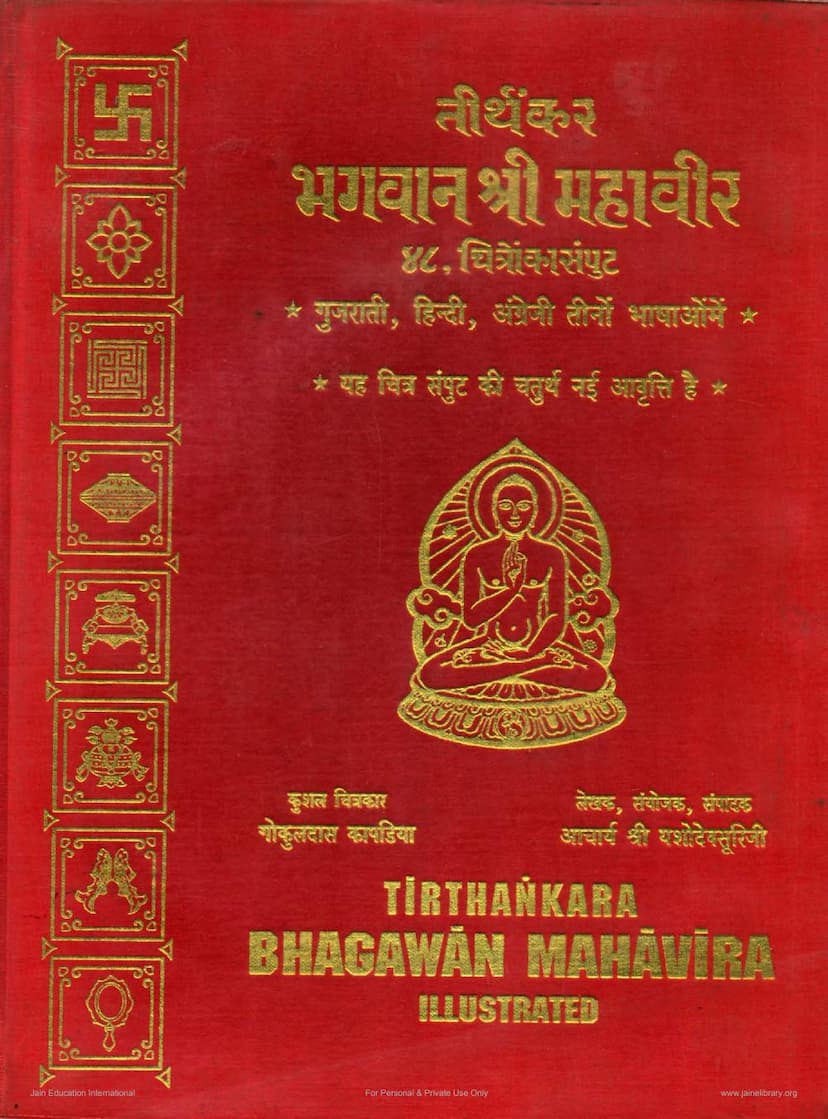Tirthankar Bhagawan Mahavir 48 Chitro Ka Samput
Added to library: September 2, 2025

Summary
Based on the provided Jain text excerpts, here's a comprehensive summary of the book "Tirthankar Bhagawan Mahavir 48 Chitro ka Samput" by Yashodevsuri:
Overview:
"Tirthankar Bhagawan Mahavir 48 Chitro ka Samput" is a significant Jain text that aims to present the life, teachings, and artistic representations of Lord Mahavir, the 24th Tirthankara. The book is multilingual, featuring content in Gujarati, Hindi, and English, making it accessible to a wider audience. This is the fourth edition of the book, indicating its popularity and enduring relevance.
Key Content and Features:
-
48 Color Paintings: The core of the book consists of 48 ornate and colorful paintings depicting various significant events from Lord Mahavir's life. Each painting is accompanied by detailed explanations in Gujarati, Hindi, and English, providing context and understanding of the depicted scenes.
-
In-depth Explanations: The text goes beyond mere descriptions, offering critical appreciations of the paintings, exploring their artistic merit and spiritual significance.
-
Previous Lives: The book provides an inspiring introduction to 26 of Lord Mahavir's preceding births, highlighting the spiritual journey and the accumulation of merits that led him to Tirthankarahood. These narratives offer valuable moral and ethical lessons.
-
Historical Appendices: Twelve very important historical appendices are included, which likely offer further insights into the socio-historical context of Lord Mahavir's life and teachings, as well as the Jain tradition.
-
Artistic Elements: Beyond the paintings, the book features 80 artistic designs and 196 images, including 80 specific designs and 144 illustrative pictures, all explained in the three languages. These artistic elements, such as borders and symbols, are highly useful and integrated with explanatory notes.
-
Multilingual Presentation: The consistent use of Gujarati, Hindi, and English across all sections ensures that the profound message of Lord Mahavir reaches a diverse readership, fostering universal understanding of Jain principles.
-
Emphasis on Ahinsa (Non-violence): The book prominently features the foundational Jain principle of Ahimsa, as articulated by Lord Mahavir. It underscores the paramount importance of respecting all sentient life, from the smallest to the largest, and abstaining from causing harm.
-
Artistic Style and Influences: The text mentions that the artwork draws inspiration from Jain-centric painting styles, particularly those prominent in Western India. It notes the influence of Iranian artists who arrived with the Mughal emperors, contributing to the development of Indian painting. The characteristic features of this art style are described as conveying much with brevity, including long, deer-like eyes, a sharp, parrot-beak-like nose, and short legs.
-
The Artist and the Visionary: The book highlights the synergistic collaboration between the artist Gokuldas Kapadia and the compiler/editor Munishri Yashovijayji (later Acharya Shri Yashodevsuriji). Their combined efforts, guided by spiritual insight and artistic skill, have resulted in a publication that is praised with exceptional adjectives like "masterpiece," "revolutionary," and "unique."
-
Publisher and Editions: The book is published by Jain Sanskruti Kala Kendra and Shri Parshva Padmavati Trust. The text details the publication history, mentioning that the first and second editions were released in V.S. 2030 and 2032 (1974 and 1976 AD) respectively, with subsequent editions growing in print runs. The fourth edition (V.S. 2060 / 2004 AD) features significant additions and improvements.
-
Detailed Explanations of Specific Incidents: The provided excerpts offer detailed explanations for specific paintings, including:
- Birth of Mahavira: Covering the celestial descent, dreams of Queen Trishala, the transplantation of the foetus by Hari-Naigamesin, and the grand celebrations.
- Early Life and Education: Prince Vardhamana's divine knowledge and surprising erudition, his wedding, family life, and the event where he demonstrated his strength.
- Asceticism and Ordeals: The commencement of his rigorous penance, wandering, and facing various temptations and hardships from gods, humans, and animals, including the incidents with the cowherd, Yaksha Sulapani, the cobra Chandakaushika, Sudamstra, and Sangama.
- Key Milestones: The vow of Candanabala and the breaking of fasts, the sermon to kings, the attainment of Kevala Jnana (omniscience), the Samavasarana (divine assembly), the procession for initiation, the plucking of hair, and his final sermon at Pavapuri, culminating in Nirvana.
- Symbolic Representations: Explanations of various symbols (pratik) and borders (patti) used throughout the book, providing cultural and religious context.
- Previous Births (Nayasara, Marichi, Vishvabhuti etc.): Detailed narratives illustrating the progression of the soul through various life forms and the impact of actions on spiritual evolution.
-
Philosophical and Ethical Teachings: The book encapsulates Lord Mahavir's core teachings, including the importance of Ahimsa, restraint, austerity, truth, non-stealing, celibacy, non-possession, and the principles of Anekantavada (non-absolutism) and Aparigraha (non-attachment). It emphasizes that these principles lead to self-realization, peace, and ultimate liberation (Moksha).
-
Emphasis on Jain Art and Traditions: The book serves as a valuable resource for understanding Jain art, its historical development, and its adherence to scriptural guidelines. It also clarifies differing traditions between Shvetambara and Digambara sects regarding certain aspects of Lord Mahavir's life.
In essence, "Tirthankar Bhagawan Mahavir 48 Chitro ka Samput" is a comprehensive and artistically rich tribute to Lord Mahavir, designed to educate, inspire, and elevate the spiritual understanding of its readers through its detailed narrative, beautiful illustrations, and profound Jain wisdom.